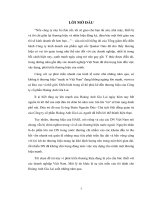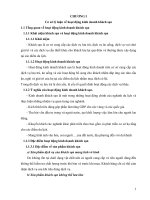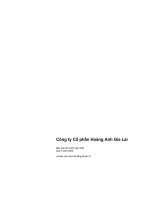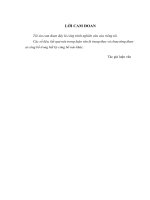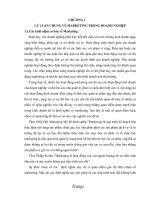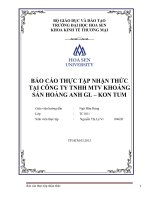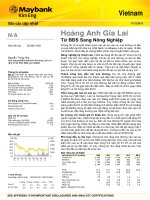Research about antisocial behaviors of employees in hoang anh gia lai group
Bạn đang xem bản rút gọn của tài liệu. Xem và tải ngay bản đầy đủ của tài liệu tại đây (1.09 MB, 53 trang )
MASTER OF BUSINESS ADMINISTRATION
INTERNATIONAL PROGRAM
RESEARCH PROJECT
(BMBR5103)
RESEARCH ABOUT ANTISOCIAL BEHAVIORS OF
EMPLOYEES IN HOANG ANH GIA LAI GROUP
Ho Chi Minh City, August 2015
Business Research Methods
ADVISOR’S ASSESSMENT
........................................................................................................................................
........................................................................................................................................
........................................................................................................................................
........................................................................................................................................
........................................................................................................................................
........................................................................................................................................
........................................................................................................................................
........................................................................................................................................
........................................................................................................................................
........................................................................................................................................
........................................................................................................................................
........................................................................................................................................
........................................................................................................................................
Advisor’s signature
Nguyen The Khai, DBA
1
Business Research Methods
ACKNOWLEDGEMENTS
To finish this article, I would like to send our sincere thanks to Dr. Nguyen The
Khai (DBA) who was enthusiastic guide us step by step to complete this study.
Moreover, he spent all his spare time to caring answered our questions during this
subject.
I also want to wish health and thanks to the employees of Hoang Anh Gia Lai
Group, they has helped me to complete the survey questionnaire correctly and on
time as scheduled.
Finally, I want to thank to the lock classmate, has created a good learning
environment so that we can share experiences and knowledge with each other
during school. Thank the ones around me encouraged and helped me during this
course.
With best regards
Ho Chi Minh City, August 2015
2
Business Research Methods
TABLE OF CONTENTS
ABSTRACT........................................................................................................................... 6
CHAPTER I: INTRODUCTION ....................................................................................... 7
I. INTRODUCTION OF HOANG ANH GIA LAI GROUP............................................. 7
1.
Over view of the company ......................................................................................... 7
2.
Development History ................................................................................................. 8
3.
Business Objectives ................................................................................................. 10
4.
Growth strategy ........................................................................................................ 11
5.
General assessment of the printing business Activities 2014 .................................. 14
6.
Human resource manager system ............................................................................ 16
II. RESEARCH INTRODUCTION .................................................................................. 18
1.
Problem statement .................................................................................................... 18
2.
Main construct.......................................................................................................... 18
3.
Research objective ................................................................................................... 18
4.
Research questions ................................................................................................... 19
CHARPTER II: LITERATURE REVIEW .................................................................... 20
I. Job Overload ................................................................................................................. 20
II. Distributive and Procedural Justice .............................................................................. 20
III. Job Stress Scale ........................................................................................................... 21
IV. Work-Family Conflict ................................................................................................. 21
V. Antisocial Behaviors ..................................................................................................... 22
CHARPTER III: RESEARCH MODEL AND HYPOTHESES ....................................... 25
I. Research model ............................................................................................................. 25
3
Business Research Methods
II. Research Hypotheses .................................................................................................... 26
1.
Job Overload ............................................................................................................ 26
2.
Distributive and Procedural Justice.......................................................................... 27
3.
Job Stress Scale ........................................................................................................ 28
4.
Work-Family Conflict .............................................................................................. 30
III. Instruments .................................................................................................................. 31
CHAPTER IV: RESULTS AND FINDINGS .................................................................. 34
I. Reliability statistics (Cronbach‟s Alpha) ....................................................................... 34
II. Descriptive analysis ...................................................................................................... 35
III. Hypothesis Testing Result ............................................................................................ 36
IV. Model Summary .......................................................................................................... 37
CHAPTER V: CONCLUSIONS ...................................................................................... 39
I. Discussion ..................................................................................................................... 39
II. Contributions ................................................................................................................ 40
APPENDIX .......................................................................................................................... 42
4
Business Research Methods
LIST OF TABLE
Table 1: Cronbach's Alpha- Internal consistency .......................................................... 34
Table 2: Cronbach„s Alpha of Construct ....................................................................... 35
Table 3: Descriptive statistics .......................................................................................... 36
Table 4: R square ............................................................................................................... 37
Table 5: Coefficients value of the model ....................................................................... 37
5
Business Research Methods
ABSTRACT
Antisocial behaviors of employees lead to unfavorable outcomes for the
organization. With this research, I used a sample of 300 employees of company to analyze
and evaluate. It has shown the impact of overload problems, distributive and
procedural justice, job stress scale, work-family conflict that affect directly to
antisocial behaviors of Hoang Anh Gia Lai Group‟s employees. Through research, it will
help the company's leadership to realize the shortcomings in the management of human
resources as well as the distribution and assess the effectiveness of the most sensible way.
6
Business Research Methods
CHAPTER I: INTRODUCTION
I.
INTRODUCTION OF HOANG ANH GIA LAI GROUP
1. Over view of the company
Vietnamese name : Công ty Cổ phần Hoàng Anh Gia Lai
Trade name: HOANG ANH GIA LAI Joint Stock Company
Abbreviated name: HOANG ANH
GIA LAI
Company‟s logo:
Slogan: UNITY IS POWER
Address: 15 Truong Chinh St, Phu Dong Ward, Pleiku City, Gia Lai Province
Tel: (84-59) 38 202 88
- Fax: (84-59) 38 200 007
Website: www.Hoang Anh Gia Lai.com.vn
Bank for opening account : at Bank for Investment and Development – Branch
of Gia Lai
Account number: 6201.000.000.7806
Tax code: 5900377720
Charter capital (up to 31/12/2014): VND 7.899.679.470.000
Hoang Anh Pleiku Private Enterprise, founded by Mr. Doan Nguyen Duc in 1993,
was transformed to Hoang Anh Gia Lai Joint Stock Company in 2006. On 22
December 2008, the company's shares were officially listed on HOSE under the
code of HAG.
7
Business Research Methods
Hoang Anh Gia Lai Group is organized according to the model of holding company
and subsidiary with the following structure:
Parent company consists of 3 corporation‟s sector management: Rubber Joint Stock
Company Hoang Anh Gia Lai, Hydropower Joint Stock Company Hoang Anh Gia
Lai, JSC Construction & Housing Development Hoang Anh.
28 subsidiaries are companies that Hoang Anh Gia Lai Group holds controlling
stakes above 50% and / or control.
2. Development History
BEGINNING STAGE: 1990 – 1993
Private company: Furniture production
1990: A small furniture workshop
1993: Building the first furniture factory; Establishing Hoang Anh Gia Lai Private
Enterprise
PUBLIC STAGE: 2002 – 2012
8
Business Research Methods
Public company: Real estate was the key business while diversification
strategies were implementing
2002:
Investing in Hoang Anh Gia Lai football club to promote Hoang Anh Gia Lai
trademark locally and internationally.
2006 - 2007:
Transforming from a private enterprise to a joint stock company
Dragon Capital and Jaccar became the Company's strategic investors
2008 - 2010:
Listing on Ho Chi Minh City Stock exchange
Raising capital from the stock market to finance plantation, hydro power and
mining businesses for sustainable developments
2011 - 2012:
Raising capital from international equity markets by listing GDR on LSE
Issuing international bonds of USD 90M via Credit Suisse
9
Business Research Methods
Issuing convertible bonds to Temasek
SUSTAINABLE DEVELOPMENT STAGE as of 2013
The group will focus its development on the two major sectors:
Agribusiness: rubber tree, sugarcane, oil palm.
Rubber and oil palm: planting 48,000 ha of rubber trees and experimenting 4,000 ha
of oil palms. Sugarcanes: total planted area is 10,000 ha
Real estate: Hoàng Anh Gia Lai Myanmar Center is considered the key project.
Developing the restructure scheme: spinning off the subsidiaries owning apartment
projects, retaining the Myanmar project and a number of projects owned by Hoang
Anh Housing Construction and Development Company.
3. Business Objectives
Vision: Turning a leading group in Vietnam and in the region with the sectors based
on renewable resources playing a key role, creating a stance for sustainable
development.
10
Business Research Methods
Mission: To constantly maintain creativity, and strive to produce products and
provide services of high quality at reasonable costs. To provide good employee
benefits, in terms of both material and spiritual encouragements in order to motivate
the employees to create new values for customers, shareholders and the whole
society.
4. Growth strategy
In its course of development, Hoang Anh Gia Lai Group has supplemented,
improved, and reinforced its development orientation. We centre on the sustainable
development to create long-term value for the shareholders and other key
stakeholders based on the following values and business philosophies.
Renewable resources: we understand that there is a limit to any natural resources;
therefore, investment in and development of renewable resources are integral to
sustainable development. In our business strategy, although being a business
working in many industries, we have decided that our business sectors based on
renewable resources will be our primary orientation to development in the future.
On such basis, over the past years Hoang Anh Gia Lai has made substantial
investment in planting rubber trees in infertile forests in Indochina conceded by the
local governments. Adopting Israeli drip irrigation system, we are able to save
considerable amounts of water and fertilizers.
Public Private Partnership - PPP: The PPP model has been applied by Hoang Anh
Gia Lai when expanding to agribusiness and investing in neighboring countries. The
PPP model was successfully applied in Laos and considered as a standard model by
Laotian Government when encouraging foreign investment into Laos. Hoang Anh
Gia Lai has provided interest-free credit to Laotian government, built infrastructures
to support SEA Games held in Laos, as well as built up many public works for local
community like airport, schools, hospitals, administration centers, houses, bridges,
roads, etc. The model is based on and consolidated by the harmonious politic and
11
Business Research Methods
economic relationships between Vietnam and other developing countries in
ASEAN.
In-depth investment and value chain: To differentiate competitive advantages in
international markets, besides the economic scale, we continuously do research and
apply new and modern technology solutions in our production process, especially in
agribusiness. We adopt intensive farming in rubber and sugarcane planting by
following the long-year experience – “first water, second fertilizer, third hard work,
and fourth seeds.” We are the pioneer to apply the Israeli dripping irrigation system
to increase the yield and to save the water. We have set up our own Rubber
Research Institute, which is the first private institute in Vietnam with professors
from Vietnam and Thailand. The rubber research institute has researched into and
analyzed the soil quality of different rubber plantations to produce particular
fertilizers to ensure the growth of rubber trees as well as to avoid wastes and to save
costs. The sugar and sugarcane industrial complex in Attapeu (Laos) is an example
of in depth investment and connecting value chain to produce sugar as the main
product and other by-products like thermal electricity, ethanol and organic fertilizer.
We also apply the value chain management to the real estate business by connecting
major links like furniture, granite, design and construction to produce costcompetitive products.
Mutual development: We understand that no success is ever made single-handed
and that our today‟s success comes as a result of trust, sharing and win-win
cooperation with shareholders, investors, partners, customers, staffs, local
communities, mass media, etc. Therefore, our business philosophy of “mutual
development” has been successfully adopted by HAG. As a result, we are one of a
few companies that is able to raise a huge capital from the domestic and foreign
financial institutions, the banks‟ assistance in hard time, and enthusiastic supports
from strategic shareholders, local communities and government authorities; we also
have an experienced and committed management team, and our staffs are always
proud of working in a competitive and active environment.
12
Business Research Methods
Medium and long-term development strategy
Since 2007, when the property market was at its peak and many non-property
companies entered into the property sector, Hoang Anh Gia Lai, a leading property
developer, did the other way round engaging in rubber business in Laos. We
understand that the property sector is quite sensitive to economic policies and
conditions, and definitely follows a cyclical pattern, so in order for sustainable
development, we need to develop other long-term key sectors. Based on the analysis
and judgement of the Group‟s SWOT, business opportunities and challenges in
respective sectors, together with the experience accumulated over the past time, the
Group has undergone restructuring with its focus on the 2 main sectors,
i.e. agribusiness and property:
Agribusiness: This is the top priority of Hoang Anh Gia Lai. Hoang Anh Gia Lai
has been investing in rubber and sugarcane plantations, and coming next is planting
other medium-term trees like oil palm. Agribusiness is considered as the Group‟s
spearhead strategy, based on the advantage of large land bank, which then supports
the application of machinery and technology to increase the yield and to reduce
production costs. The PPP model applied through investment in “offering
infrastructure in return for concessions to develop agribusiness” has enabled
HOANG ANH GIA LAI to develop an enormous land bank in neighboring
countries. This sector can bring a very high profit margin, creating substantial cash
inflow and stable growth, thus making the group invulnerable to negative impacts
from highly-cyclical and vulnerable traditional business sectors when exposed to
volatile economic circumstances.
Property: Hoang Anh Gia Lai is still a leading property developer with definite
advantage in the segment of medium-end apartment projects thanks to the
advantages gained from furniture, granite production, to designing, construction and
effective cost management. However, the property sector is cyclical and risk-taking,
so Hoang Anh Gia Lai formulates a strategy for geographical diversification into
13
Business Research Methods
other less developing countries in ASEAN. Currently, the property sector in
Vietnam still faces a lot of difficulties without signs of revival, so Hoang Anh Gia
Lai only decides a few marketable projects to develop. Instead, the Group, by sheer
determination, makes investment in the giant project in Yangon, Myanmar in an
effort to take advantage of the property market fever that Myanmar is undergoing
after this country has announced its open-door policy and passed the Foreign
Investment Law with many less restrictive terms.
5. General assessment of the printing business Activities 2014
Advantages:
HAGL possesses an enormous bank of adjoining land which enables the strategy of
developing high-technology agribusiness, mechanizing all the steps including soil
preparing, planting, caring, harvesting, transporting, processing, etc. thus producing
high yields and competitive prices.
HAGL‟s dynamic, highly-experienced executives and employees are willing to
acquire new knowledge. Therefore, in 2014, HAGL was able to quickly and
impressively start its dairy and beef cattle farming. The diversity of agribusiness
helps HAGL more effectively deal with the complicated situation of the economy,
laying a solid foundation for more sustainable development in the future.
The thriving real estate market in Myanmar is experiencing a higher and higher
demand exceeding the supply. The Myanmar Project, a significant factor retains
HAGL‟s success in the real estate business. Though the year 2014 did not witness
any revenue or profit, the project maintains its shareholders and investors‟
confidence in the Group‟s capabilities in the real estate business.
A steep decline in the common interest rate, stable value of the Vietnamese dong,
inflation under control, etc. all alleviate and stabilize the costs and finance-related
risks as well as capital sources, reassuring HAGL of embarking on its investment
projects.
14
Business Research Methods
The shareholders‟ companionship and deep attachment have solidified HAGL‟s
sustainable developmental trend.
Another factor that cannot go unmentioned is the close interest and substantial
assistance from the leaders of Parties and Government agencies of Vietnam, Laos,
Cambodia and Myanmar. Thanks to them, the procedures for assessing and
approving investments, capital transfer were performed with ease
and less time consuming. Anyway, that has encouraged HAGL‟s every confidence
in making investments in projects under complicated and challenging economic
circumstances.
Difficulties
The year 2014 witnessed a drop in the price of rubber, significantly decreasing
the profit ratio of this business sector. Therefore, HAGL took the initiative to relax
the workload, tapping only big trees just for the purpose of training and retention of
the workforce.
The harsh protectionist policies on Vietnamese sugar products constitute obstacles
to the import of sugar products from Laos into Vietnam. As a result, HAGL still
cannot break into this thriving market where the prices are higher the world‟s
average prices.
The stock market has not experienced changes significant enough to reach
sustainable development. As a consequence of temporary, stopgap trades, issuance
of new stocks for mobilizing long-term capital proves unlikely to succeed.
In the monetary market, most of the savings go for short-term deposits, this
discouraging the banks from providing long-term funding for projects.
HAGL‟s managerial and organizational structure is still approaching perfection to
match the Group‟s restructuring process and business redirection.
Achievements in business operation and administration
15
Business Research Methods
The most prominent achievement in 2014 was the flair for expansion of business
scope into dairy and beef cattle farming. For HAGL in particular and Vietnam in
general, the diversification into livestock farming would help reduce risks and
dependence on fluctuating prices of farming products. Featured with a short capital
turnover, cattle farming enable HAGL to turn over its capital, making prompt cash
flow and profit to offset the deficits in the turnover targets and profit in the rubber
business. All the processes of corn and grass growing, food processing, feeding,
caring, milking are mechanized, yielding products meeting the standard of stable
quality and affordable prices.
The Group‟s restructuring activities began to take positive effects in 2014. Business
sectors underwent a restructure toward an effective streamlined organization.
Thanks to it, there was a considerable decline in the costs and expenses, leading to
an improvement in the Group‟s competitiveness and ability to deal with adverse
development in the market. In 2014, HAGL was also shift the management to
younger staff to make preparation for replacement of elderly
leaders approaching retirement. This planned shift combined the young‟s freshness
and dynamism with the elderly‟s experience and sophistication, which made a
major breakthrough in every aspect.
6. Human resource manager system
Hoang Anh Gia Lai group includes the parents company, 3 major corporations in
charge of relevant sectors and 28 subsidiaries as in the following organizational
structure.
Working mode: Group perform work mode 5.5 to 6 days / week and 8 hours / day.
However, depending on job conditions require that the unit can change the working
time during the day to match or overtime but must ensure that the standard hours of
work day by the Group stipulated.
Employees are entitled to 1 to 1.5 days / week. Staff working for 12 months to be
entitled to 12, 14 or 16 days / year, depending on working conditions. If less than 12
16
Business Research Methods
months, the annual leave is calculated according to the number of months worked
during the year. The Group will increase the number of vacation days based on the
working time of employees, each 5 years of service are entitled to one day be. Also,
every year, all the Group's employees are public holidays in accordance with the
laws of Vietnam and the host country where HOANG ANH GIA LAI are the
production and business activities. If the date coincides with other holidays, the
staff will be made up the next day.
Employment, training policies: Recruiting new personnel in accordance with
procedures set up to ensure newly employees have sufficient qualifications, skills
and experience for the position to be recruited and have good moral character, have
aspirations flock long with the Group. In the longer term, the Group priority in
recruiting local manpower because of its stability and high quality. The Group has
special preferential policies for local people with real power and have good ethics
working in the major cities to return to work in the Pleiku City and the project area.
Group ensures all staff are trained to have sufficient technical capacity, implement
the assigned work. The training and coaching skills and expertise needed to be done
at work or training courses outside the planned training of the Group was
established since the beginning of the year.
To perform well in training, the Group and the employee agreed commitments on
obligations and rights of both parties in the process of learning, the ability to work
and time served the Group after accomplished learning.
Labor safety policy is a key policy priority. Hoang Anh Gia Lai focused
occupational safety training for workers before entering the work, labor protection
equipment for workers, such as clothing, hats, shoes, glasses, ... fully and promptly
the nature job entails.
Issue regulations on occupational safety, environmental hygiene, regularly check
the evaluation of occupational safety at construction sites. The Group has
established work wear Council to organize protective padding system.
17
Business Research Methods
II.
RESEARCH INTRODUCTION
1. Problem statement
With the rapid development of the Group in recent years, it has generated a lot of
work to be solved and the requirements of businesses with employees as well as
advanced. Prior to that issue, the employee will easily fall into overload at work
with time to complete work urgently and more. From there, they feel constantly
under pressure, anxiety about the job because there is more work but have little time
to do so to bring jobs back home to settle and feel no balance between work and
family life.
On the other hand, arranging the work in parts and a complete assessment of the
employee's duties are fairly well make them feel tense.
From the above problems can cause stress for employees, they fall into a poor
working efficiency, and affects other employees and adversely affect results of
operations of the entire company.
With these problems, this research was conducted to check the status of stress
worker due to work overload to antisocial behavior in this group.
2. Main construct
Based on information from the human resources of the company has discovered that
some employees worked less effective, attitude is not good behavior for company
colleagues and negatively impact operations the business of the company.
3. Research objective
The objective of this research was to develop a better understanding of the impact
of job overload, distributive and procedural justice, job stress scale, work-family
conflict to antisocial behaviors. From this research helps corporate leaders to take
measures to adjust to minimize this situation to bring efficiency to business
operations.
18
Business Research Methods
4. Research questions
The research was based on the association between factors such as job overload,
distributive and procedural justice, job stress scale, work-family conflict impact
directly or indirectly to antisocial behaviors of employee at HOANG ANH GIA
LAI group. So the question arises will revolve around a number of issues the
following:
How overload job status will impact how to antisocial behaviors of employee?
How distributive and procedural justice status will impact how to antisocial
behaviors of employee?
How job stress scale status will impact how to antisocial behaviors of employee?
How work-family conflict status will impact how to antisocial behaviors of
employee?
19
Business Research Methods
CHARPTER II: LITERATURE REVIEW
This chapter will be presented revolve around issues such as definition, theory,
conceptual research model, summary of hypotheses of the problem such as:
(1) Job Overload
(2) Distributive and Procedural Justice
(3) Job Stress Scale
(4) Work-Family Conflict
(5) Antisocial Behaviors
(6) The Antisocial Behavior of Employees
I.
Job Overload
This measure, developed by Caplan, Cobb, French, Van Harrison, and Pinneau
(1980), uses 11 items to describe an employee‟s job overload. This focuses on the
employee‟s perceptions of quantitative job overload (rather than mental strain or
psychological pressure). It asks for description of the perceived pace and amount of
work.
Job overload correlated positively with hours worked, competitiveness, firm size,
and absenteeism and correlated negatively with work satisfaction, job satisfaction,
and professional commitment (Dwyer & Ganster, 1991; Phelan et al.. 1993; Sargent
& Terry, 1998; Wallace, 1997).
II.
Distributive and Procedural Justice
These measures were developed by Joy and Witt (1992). They are parsimonious in
that they each use only three items to access distributive and procedural justice. The
procedural justice measure focuses on the extent to which employees believe they
have a voice in negotiating their job assignment, job duties, and performance
appraisal results. The distributive justice measure focuses on the fairness in the
20
Business Research Methods
decisions made by the organization concerning job assignments, job duties, and
performance appraisals.
Distributive and procedural justices were positively correlated. The relationship
between distributive and procedural justice was smaller for employees when delays
in gratification were shorter (Joy & Witt, 1992).
III.
Job Stress Scale
This measure was developed by Parker and Decotiis (1983). The measure uses 13
items to measure job stress along two dimensions. One dimension is time stress
(feelings of being under constant pressure) and the second dimension is anxiety (job
– related feelings of anxiety). Jamal and Baba (1992) used a shortened version of
the Job Stress Scale consisting of nine of the items.
Job stress was negatively correlated with organizational commitment and job
satisfaction and positively correlated with role ambiguity and overload (Jamal &
Baba, 1992). Factor analyses have shown that time stress and anxiety are
empirically distinct dimensions (Melamed et al.., 1991; Xie & Johns, 1995).
IV.
Work-Family Conflict
This measure, developed by Kopelman, Greenhaus, and Connolly (1983), uses eight
items to assess the extent of the interrole conflict that occurs between work and
family roles (work-family conflict). Grandey and Cropanzano (1998) suggest that
by reversing the wording of the items so that the stressor is family demands, the
measure can also be used 10 describe the spillover of family responsibilities to work
roles (family-work conflict).
Work-family conflict correlated positively with job involvement, work role conflict,
work role ambiguity, work time demands, family role conflict, and family time
demands. It correlated negatively with social support from work and family, family
satisfaction, job satisfaction, and life satisfaction (Adams et al., 1996; Carlson &
Perrewé, 1999). When both the work-family conflict items and the items reworded
21
Business Research Methods
to assess family-work conflict were examined in a factor analysis, two distinct
factors were found with the items loading appropriately on the separate factors.
V.
Antisocial Behaviors
This measure was developed by Robinson and O‟Leary – Kelly (1998). It describes
negative behaviors by employees that have the potential to harm individuals and/or
the organization. Antisocial behaviors include breaking rules, damaging company
property, hurting other workers, starting arguments with co-workers, and saying
rude things about a supervisor or the organization.
Employee antisocial behaviors correlated positively with group antisocial behavior
and correlated negatively with general satisfaction. Group antisocial behaviors
correlated positively with an individual‟s tenure in the group and correlated
negatively with gender, age, job tenure, and the intention to leave. Antisocial
behaviors correlated positively with similar measures such as antagonistic
behaviors.
Antisocial
behaviors correlated negatively with
organizational
citizenship behaviors (Robinson & O‟Leary Kelly, 1998).
The Antisocial Behavior of Employees
Workplace deviant behavior is defined by Robinson and Bennett (1995: 556) as
“voluntary behavior that violates significant organizational norms and in doing so
threatens the well-being of an organization, its members, or both”. Robinson and
Bennett (1995) define two types of behaviors related to employee deviance as the
ones directed against the organization and the other directed against the coworkers.
The first type of behaviors is „organizational deviance‟, whereas the second type of
behaviors is „interpersonal deviance‟. The authors further separate „organizational
deviance into two as „production deviance‟ and „property deviance‟, where
„production deviance‟ is considered to be a minor deviance and „property deviance‟
is considered to be a serious deviance. Examples include leaving early, taking
excessive breaks, intentionally working slow, wasting resources for „production
deviance‟ and sabotaging equipment, accepting kickbacks, lying about hours
22
Business Research Methods
worked, stealing from company for „property deviance‟ (Robinson and Bennett,
1995). According to the authors, „interpersonal deviance‟, on the other hand,
consists of behaviors that occur among coworkers. „Political deviance‟, such as
gossip, favoritism, blaming coworkers, competing non-beneficially are examples for
minor deviance, and „personal aggression‟, such as sexual harassment, verbal abuse,
bullying, stealing from co-workers and endangering co-workers are examples for
serious deviance (Robinson and Bennett, 1995).
„Workplace
deviance‟
has
been
conceptualized
in
many
ways
(i.e.
counterproductive work behavior, mobbing/bullying), „antisocial behavior‟ being
one of these. Robinson and Greenberg (1998) states that there exists no generally
agreed upon definition of workplace deviance. Among the most prominent areas of
study that relate to deviant behavior are antisocial behavior, counterproductive
behavior, dysfunctional behavior, and organizational misbehavior (Kidwell and
Martin, 2005:5). The common theme which all of the concepts have is the harmful
effect of such behaviors to the organization. In their research, Robinson and
O‟Leary-Kelly (1998) use „antisocial behavior‟ broadly to describe the negative
behaviors in organizations. Giacalone and Greenberg (1997) also describe
„antisocial behavior‟ as „any behavior that brings harm, or is intended to bring harm
to the organization, its employees, or its stakeholders”. According to Giacalone and
Greenberg (1997), antisocial behavior focuses more on personal, political, and
property interactions and less so on production, with the exception of sabotage
(Giacalone & Greenberg, 1997). Antisocial behavior includes aggression,
discrimination, theft, interpersonal violence, sabotage, harassment, lying, revenge
and whistleblowing (Kidwell and Martin, 2005).
In order to predict deviant behaviors in the organizations, Hollinger (1986) suggests
the importance of personal characteristics and perceptions and attitudes of
employees about their employer. Apart from the individual factors that affect
deviant behaviors, factors related to the organization plays an important role. Sims
(1992) indicates that the organization‟s support or encouragement of such behaviors
23
Business Research Methods
forms the major reason for the occurrence of these behaviors. In addition,
Appelbaum et al (2005) suggest that deviant role models within the organization
will lead the employees to have deviant behaviors. Therefore, it is important to
consider organizational factors that creates or prevents the occurrence of antisocial
behaviors.
24

